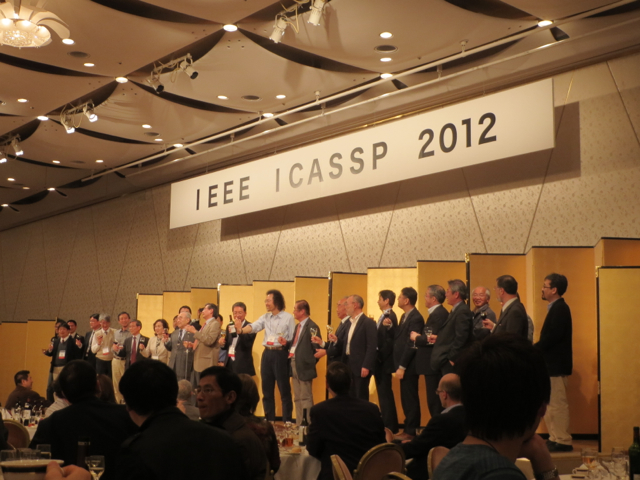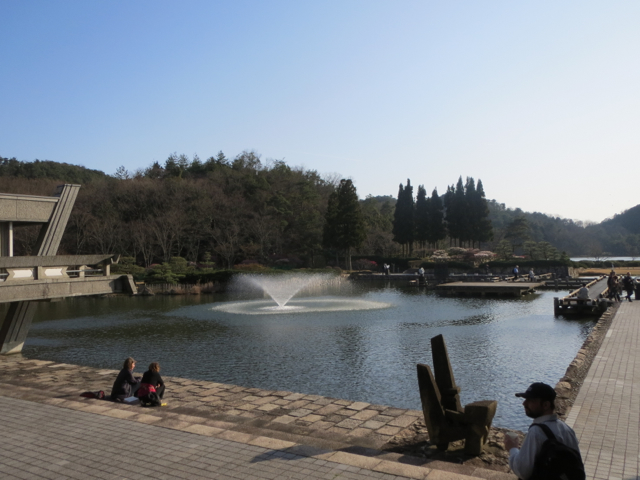Submitted by Ingrid Jafari on Mon, 04/23/2012 - 05:31
The 37th IEEE International Conference on Acoustics, Speech and Signal Processing, (ICASSP) was held in the city of Kyoto, Japan, from the 25-30 March 2012. ICASSP is the world’s largest and most comprehensive technical conference for signal processing and its applications. Over 1 350 papers were presented at ICASSP, taken from more than 2 700 submissions. The papers were divided into 15 categories ranging from audio/acoustic signal processing to information forensics and security to signal processing education (just to name a few!).
Each day, the conference commenced with a plenary talk, including: Prof. Karlheinz Brandenburg from Technische University Ilmenau in Germany with his talk entitled “Audio and acoustics signal processing: the quest for high fidelity continues”. Prof. Chin-Hi Lee from Georgia Institute of Technology in the USA also presented: “From signal processing to information extraction of speech: a new perspective on automatic speech recognition”. Other speakers included Prof. Stephane Mallat from Ecole Polytechnic in France, and Dr. Mitsuo Kawato from ATR Computational Neuroscience Laboratories in Japan; their speeches were entitled “Can signal classification speak mathematics?” and “Computational neuroscience, brain decoding and neurofeedback” respectively. The plenaries were quite diverse in topics, which ensured that all attendees at ICASSP had something relevant to their field of expertise.
Prior to the commencement of the regular technical programme, fifteen tutorials were scheduled over the first two days of the conference. Each tutorial was of a half-day duration covering a broad range of topics. I attended the tutorial entitled “Reverberant Speech Processing for Human Communications and Automatic Speech Recognition”, jointly presented by leading researchers from NTT Laboratories (Dr. Tomohiro Nakatani) and University of Erlangen-Nürnberg (Prof. Walter Kellermann and Dr. Armin Sehr). This tutorial proved to be highly useful and relevant to my current field of research (reverberant blind source separation and recognition). The technical programme commenced on the 27 March, with parallel oral, poster and special sessions at any given time. There was also a show-and-tell session which spanned over two afternoons, these included hardware/software demonstrations by leading research groups in industry, academia and government.
I had the opportunity to present my research, entitled “A robust approach to reverberant blind source separation in the presence of noise for arbitrarily arranged sensors”, in a lecture format. This was definitely a very good experience as it allowed me to present my work to leading experts in the same field. I also had the opportunity to meet and discuss my work with some researchers who I had met at Interspeech 2011 last year.
Being only the second time in ICASSP history that the conference has been hosted by Japan (the previous time being in 1986), it was a very special conference with a high emphasis placed upon the attendees experiencing the Japanese culture. For example, the conference packs contained some traditional Japanese sweets, as well as a special cloth (with detailed instructions for use by the foreigners!), and various maps/tour guides. This was complemented by a comprehensive social programme - including a welcome reception, banquet and traditional tea ceremony. The welcome reception was hosted on the Monday of the conference week, with the traditional Kagamibiraki, opening of the Japanese sake cask, performed. The ICASSP banquet was truly an affair to remember - the evening commenced with traditional Japanese dance/music performances by Maiko and Geiko, followed by a delicious multi-course dinner. The evening concluded with a lively, passionate performance by some Taiko drummers and musicians. Additionally, for the ladies of the ICASSP, there was a “Women in Signal Processing” Luncheon sponsored by Raytheon which enabled the women to meet and discuss various topics surrounding the field in which we all are involved in. The social programme of ICASSP was designed very well with the events complementing each other, and thus allowing the attendees ample opportunity to meet each other in a social environment.
The attendees of ICASSP were also fortunate to be blessed with good weather - at least for the last couple of days! We all experienced a cold start to the conference but this soon disappeared with some weather more reminiscent of spring; however there was an obvious lack in presence of “hanami” (Japanese cherry blossoms) - many of the native Japanese at ICASSP apologized to us for this! However, we were lucky enough to see a few blooms on the conference grounds.
In conclusion, the 37th ICASSP was a most enjoyable and beneficial experience for me. Not only was I able to see the cutting-edge research that is being conducted in my field of research, I had the opportunity to meet with other researchers who I had previously met, as well as make valuable new contacts. And of course, the experience of the Japanese culture was an invaluable aspect of it!

Members of IEEE Signal Processing Society and the ICASSP organising committee

View of the conference grounds

Cherry blossoms!
